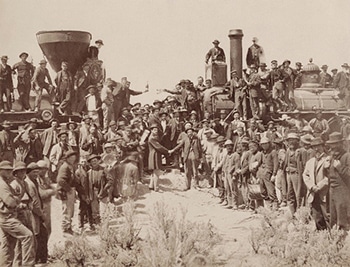How can we best use technology to support teaching and learning? It can feel overwhelming to keep up with the changes, but that struggle to keep up is not at all new.
Sometimes, looking at similar challenges in a new context can help make things easier to grasp. Another field that has always been moving forward at the speed of technology is farming. It might not align with your preconceived notions of how food gets to your table, but technology is an integral part of how many farms stay viable.
Farming is, and always has been, among those leading the way in technology through the industrial revolutions.

Agriculture during the first industrial revolution
The first industrial revolution helped us move from an agrarian society to one where more tasks were mechanized.
In the 18th and 19th centuries, people started to move away from farms and into cities, where new types of employment became available. Among the notable inventions during this period were reliable steam engines, transatlantic cables and mechanical sewing machines.
Farmers were not left out of this period of innovation. The cotton gin helped automate the separating of cottonseed from the cotton fiber. This, combined with the inventions of the spinning jenny, which made finishing cotton easier, and the flying shuttle, an advanced loom, revolutionized cotton growing and how it worked with the increasingly factory-based textile industry.

Agriculture during the second industrial revolution
The second industrial revolution is tied to advances like telephones, light bulbs, diesel engines, airplanes, the Model T and the introduction of assembly lines. New forms of transportation did more than help move people. They also helped move crops, livestock and farming machinery, expanding markets and making farms more efficient. The expansion of the railroad during the second industrial revolution meant that, for the first time, Midwestern farms could transport goods to the Pacific and Atlantic coasts.

Agriculture during the third industrial revolution
The third industrial revolution, which is sometimes called the digital revolution, saw technology advancing from mechanical and analog to digital. This technological revolution was one piece of how the agriculture industry could keep up with population growth, which grew by 65% between 1960 and 2008.
Digital tools gave farmers the ability to record and analyze more data to engage in precision farming. In the 1990s, farmers started using satellite technology to innovate farming practices, and the FDA granted the first approvals of foods produced through biotechnology. Agricultural technology experienced many advances during the third industrial revolution, allowing farmers to start using weed- and insect-resistant crops, genetically engineered crops and more advanced insecticides.
Agriculture during the fourth industrial revolution
As referenced in The Future of Learning: Redefining Readiness from the Inside Out, during this fourth industrial revolution, we see physical, digital and biological technologies. Smart farming practices allow for precise monitoring and automation of agricultural processes, leading to increased crop yields, optimized resourcing and enhanced sustainability, all while making farming more efficient and data-driven. One example is smart irrigation, where sensors and weather patterns are used to maintain crop watering schedules.
The future and technology
Around the world, farmers and technologists – not mutually exclusive categories – will be looking for ways to be more efficient, increase output and keep people fed. The technology is a piece of the puzzle to do that – a tool to help support effective practices. When we look at teaching and learning, what role can and should technology play? The answer to that does not and cannot be a static one. It needs to evolve alongside the technology and with our understanding of what knowledge, skills and attributes we want our learners to have.







